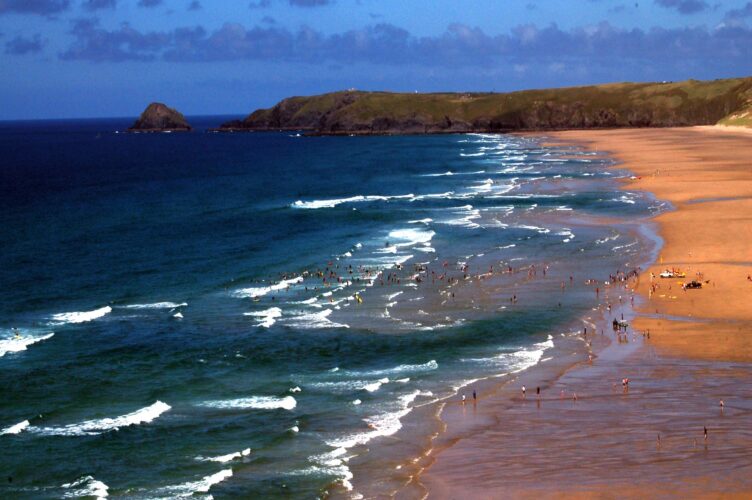Every year, at many of the busiest surf beaches up and down the exposed southwest of England and Wales, there are days when all the elements come together causing mass rip current rescues. These incidents are often a result of a volatile mix of strong rip currents, attractive bathing conditions (warm and sunny) and lots of people (e.g., BBC reports from July and August, 2013 http://www.bbc.co.uk/news/uk-england-cornwall-23496123; http://www.bbc.co.uk/news/uk-england-cornwall-23851640).
The cause is often a pulsing rip current that catches bathers and bodyboarders off-guard, moving them into deeper water and offshore, requiring the assistance of lifeguards to help them back to the safety of the beach. The sheer number of people in the water makes these rescues particularly difficult for lifeguards to deal with.
Wave, tidal and sandbar conditions are often very similar up and down the coast. This means that during especially hazardous days, in holiday periods, mass rescues occur at multiple beaches at the same time.
These incidents often attract press attention and there are always some wild explanations in the media for their cause. Many theories put the rescues down to flash rips appearing out of nowhere or the infamous ‘collapsing sandbar’. This article on a mass rescue at Perranporth in 2005 is a good example of general lack of understanding of rip current behavior (http://news.bbc.co.uk/1/hi/england/cornwall/4134220.stm).
This myth has little basis in reality, as sand bars just do not collapse. Dr Rob Brander, a coastal scientist and rip expert from Australia, believes that the myth began on Sunday 6 February 1938 at Bondi Beach; “It was a beautiful summer day and many of the 30 000 people at the beach were splashing around in the water standing safely on the shallow sand bars. According to eyewitness reports, everything was fine until three large waves approached the shore and broke.
Soon after that, a bunch of swimmers suddenly found themselves in deep water being dragged into a deep channel and out to sea. Approximately 60 surf lifesavers conducted a mass rescue during the ensuing hysteria and panic. In the next 30 minutes, 250 bathers required assistance, of which 35 were rescued unconscious and revived, while tragically five drowned”.
Today, that infamous mass rescue is still often reported as being caused by a collapsing sandbar. But, there is a much more likely explanation for these kinds of incident that is in line with what we already know about rip behaviour. A likely sequence of events would be related to a pulsing rip current as follows:
- 1) Larger wave group – a larger wave group or ‘set’ of waves breaks.
- 2) Raised water levels – the wave breaking causes a rise in the water levels at the beach. This may cause bathers to loose there footing and give the impression that the seabed was moving away from them.
- 3) Pulsing rip current – the increased wave breaking and change in water levels would temporarily increase rip current speed.
- 4) Sandy water – The combination of the stirring-up of the sand by the breaking waves and the turbulent water created by the pulsing rip current often turns the water sandy.
- 5) Movement – Once bathers have lost their footing they are moved on the current more easily into deeper water, again giving the impression that the sandbar has moved away from underneath them.
These conditions can occur quite regularly in the summer, but there are a few additional circumstances that increase the likelihood of a mass rescue incident occurring on just a handful of days each season.
- Changing conditions – nothing catches inexperienced bathers off-guard more than a rapid change in conditions, particularly when waves and currents have been calm for a number of days/weeks. Inexperienced bathers and sometimes lifeguards will be unaware of where the rip currents are and how strong they can be, simply because they haven’t been active for a long period. The beach may have changed since the last time they were active or it might be a different stage of the spring/neap cycle that will affect the amount of sandbar exposure and rips at low tide.
- Long period swell – swell waves with a longer period (more than 10 seconds) have more energy and are arrive in groups or sets with long lulls between the groups of larger waves. During the long lulls the surf and rips can be very calm and then spark into action when the wave groups arrive. This effect can be at its most hazardous with the arrival of the longest period waves (more than 16 seconds) of a new swell.
- Lots of people – finally, the major factor in these conditions becoming mass-rescues by lifeguards is the overloading of bathers and bodyboarders in the surf zone.

